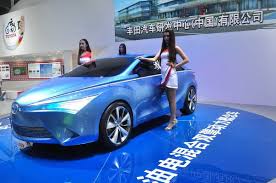Consumer preference:
- With a country of 1.3 billion people, the consumer base is so broad that it covers all kinds of segments. There are certainly people who are cautious over costs, and there’s a low-cost market predominantly dominated by Chinese automakers. But there is the high-end segment as well which is growing fast.
- From an online research about “will you consider to buy a HEV (Hybrid-Electric Vehicle)” involving around 353 netizens (done by Netease) in 2009, 69% of them voted for “HEV is too expensive that I cannot afford it even if I want to buy”, 24% of them selected the option “I definitely will buy”, 4% of them thought HEV is not that important and may not consider, 2% of them have no idea what HEV is.
Sales performance in 2011: Sales of all-electric cars and hybrid autos reached 5,579 units and 2,580 units, respectively, in 2011, dwarfed by the country’s total sales of 18.55 million vehicles.
Sales performance in 2012: Even with the help of generous government subsidies Chinese consumers bought only 11,375 electric cars in 2012, a paltry sum in the world’s biggest car market where vehicles sales reached 19.3 million the same year, according to the China Association of Automobile Manufacturers.
Expectations from auto makers like Toyota and VW: hope hybrid sales will get a lift with the next round of government policies that could offer more favorable purchase subsidies on hybrids. In the past, such subsidies have been heavily tilted towards electric vehicles.
Government policy:
- Due to China’s backward hybrid car manufacturing technology and severe lack of plug-in infrastructure in the past few years, relevant government administration had intended to advocate researching EV directly and jumping the hybrid research. However, this overwhelming policy has not been supported by the market performance and reflection. Except for government purchasing, individual EV market has never been launched. In addition, the fact that sales of hybrid cars in Japan and other european countries were much better than EV’s in those regions is the best example to compare the market between EV and hybrid cars. That is why the industrial transformation plan released by the State Council in 2011 modified its developing path to research on EV, hybrid car markets and other new energy vehicles.
- There are signs that a shift is beginning. Miao Wei, head of the Ministry of Industry and Information Technology, said China would make changes to the existing subsidy program to vary according to the degree of a vehicle’s fuel efficiency—the more fuel-efficient a car, the greater the subsidy will be.
- In 2012, the subsidies from government towards hybrid car buyers are ranged from 28 thousand RMB to 50 thousand RMB according to the level of fuel economy.
Powerful leader: the hybrid car technology of Toyota is regarded as the most mature. Camry, Prius, and Lexus CT200h are the best representatives of hybrid car made by Toyota. As to July of 2012, the total volume of hybrid cars made by Toyota reached 3 million units.
Chinese domestic players: BYD, Chery, Great Wall, and Hafei have already begun research on hybrid cars since 2009.
Types of Hybrid Cars in China:
| Name | Fuel Economy | Representative | Price |
| Mild hybrid | 10% | Chery A5SG | 74 000 |
| Power assist hybrid | 20% | Civic Hybrid | 269 000 |
| Full hybrid | 40% | Toyota Prius | 259 – 278 000 |
| Plug-in hybrid | 70% | Chevrolet Volt | N/A |
BYD
· BYD is emerging as leader in the electric car sector.
- Sales performance in 2012: a total of 456 000 units with a growth of 1.69%.
- Hybrid cars: BYD F3DM was launched in 2008 and began to sell to individuals in 2010 with the price at 149 000 RMB.
- Sales performance:
- Original expectation of sales from BYE: in June 2010, the PRM of BYD answered an interview and told the expectation of BYD F3DM’s annual sales was 1000 units.
- Actual sales: sold just 80 units since its debuts in 2009
- Plan in 2012:
- BYD’s Qin sedan will replace poor-selling F3DM and can go from 0-62 miles per hour in less than 7 seconds because of lighter batteries.
- Qin is planned to be sold for about 200,000 Yuan, compared with the F3DM for 149,800 Yuan – 169,800 Yuan.
- The cost of using a Qin is said to be about 16 Yuan per 100km.
- Sales performance in 2012: since it began to sell in China last year, the total amount of DS car sold in China is merely several hundred. And lower than the expectation of PSA group.
- Marketing position:
- luxury car
- fusion with fashion elements: DS shows in auto show, Paris fashion week, shanghai fashion week, ELLE China Fashion Awards.
- Store in China:
- 1st store was established in Nanjing in June of 2012
- A total of 30 stores were set up until the end of 2012
- Developing path:
- DS5 was launched in April 2011
- DS4 / DS5 began to sell in June 2011
- DS3 began to be launched in China in August in 2011.
- In 2014, two new types of DS cars will be launched which will include a type of SUV
- Expectations of sales in 2015: 200,000 units (planned by Cai Jianjun, vice president of Changan PSA Automobiles Co., Ltd)
- Type of DS car sold in China: DS3, DS5, DS4
Example of a brand creation in China: DS
- Sales performance in 2012: since it began to sell in China last year, the total amount of DS car sold in China is merely several hundred. And lower than the expectation of PSA group.
- Marketing position:
- luxury car
- fusion with fashion elements: DS shows in auto show, Paris fashion week, shanghai fashion week, ELLE China Fashion Awards.
- Store in China:
- 1st store was established in Nanjing in June of 2012
- A total of 30 stores were set up until the end of 2012
- Developing path:
- DS5 was launched in April 2011
- DS4 / DS5 began to sell in June 2011
- DS3 began to be launched in China in August in 2011.
- In 2014, two new types of DS cars will be launched which will include a type of SUV
- Expectations of sales in 2015: 200,000 units (planned by Cai Jianjun, vice president of Changan PSA Automobiles Co., Ltd)
- Type of DS car sold in China: DS3, DS5, DS4
Written by Daxue Consulting Marketing Research China






